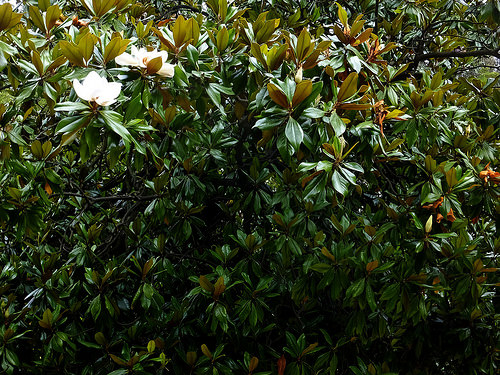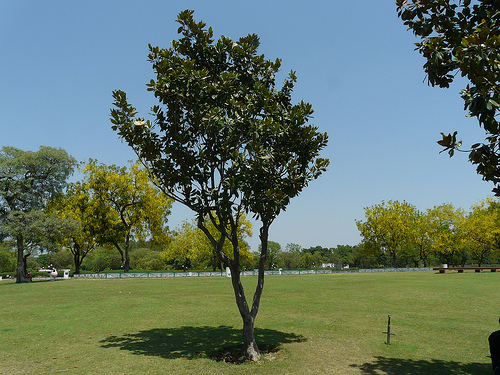Evergreen street tree for Zone 14

Gardening Question from Tony:
I am looking for a tree to plant along the front of my house next to the sidewalk, Sunset zone 14, clayey soil. Preferably evergreen, drought tolerant, carefree, not taller than 25 feet. From your website, I’ve found Rhaphiolepis and Lephostemon Confertus. I also like the Cotinus Obvatus, which is deciduous. I’m interested in your feedback and suggestions as to suitability.

Photo by dinesh_valke 
Answer from Pat:
Sunset Zone 14 means Napa Valley, Sonoma, Healdsburg, Santa Rosa, and Petaluma to me—in other words, vineyard country. Another area with Zone 14 temperatures is the San Joachim Delta, including Stockton, Modesto, and Sacramento. All these areas have many towns, such as those I’ve mentioned, with a multitude of street trees to choose from, but most street trees in these areas are deciduous. Here are some trees other than those you’ve mentioned: cork oak (Quercus suber) is drought-resistant and slow growing, so it would remain shorter than your prescribed height for your lifetime. It is characterful and choice as a street and garden tree in a drought-resistant landscape. There is one in my neighborhood that is rarely watered, seldom if ever pruned, and in fifty years that I’ve known it has never grown taller than 25 feet. Living in Zone 14, I think I would choose to plant this since it fits the atmosphere of the area. Most other oaks are too large and more subject to the diseases currently afflicting native oaks. Another idea is Western redbud (Cercis occidentalis) Highly drought-resistant, though deciduous. Nonetheless this native tree this can be a satisfying to grow where you can enjoy its beauty and needs no irrigation. Another idea, and I think a better one is is Amur maple (Acer tataricum ginnala ‘Flame’) Native to Manchuria, this choice tree with three-lobed, toothed leaves needs at least moderate irrigation but gives a lot in return. It bears fragrant blossoms in spring, followed by colorful red seed pods. This is a small tree, good at street-side, with head-turning autumn color. This tree uplifts spirits even on a dull day, but when sunlight shines through those crimson leaves the effect is breathtaking. A little light pruning and pinching is all it takes to maintain a good shape.
First: Cork oak (Quercus suber) is not a deciduous tree. It is an evergreen like you wanted, making it an excellent choice for you in climate zone where you live. Cork oak is native to the Mediterranean region, but all of our California live oaks of various species are evergreen. This is why we call them “live” oaks, because they don’t drop their leaves in winter. California hillsides covered with these dark green oaks are a characteristic sight in the very climate zone in which you live. They are not deciduous. They are evergreen. None of these live oaks were small enough to fit your needs or I would have suggested one.
Regarding Brisbane box (Lophostemon confertus) I should have pointed out that it will survive in Zone 15 up, but Zone 14 is too cold. It would not like the extremes of heat and cold where you live. When one thinks of evergreen trees where you live, one thinks of conifers and oaks first. I didn’t think you wanted a conifer, since most of the smaller ones are more like shrubs than trees or they have stiff formal looks. In general they don’t have the quality you seemed to be looking for in a smaller street tree.
Yes, your suggestion of India hawthorne tree (Rhaphiolepis indica ‘Magestic Beauty’) is a good idea. It should do all right in your zone. You can probably find a tall one at a tree farm. (These trees can be ordered from Monrovia Nursery but then you can’t make sure you got a good bright pink flower color.)
It went through my head when you first wrote that maybe you would like to consider a magnolia. There are quite a few magnolias in Walnut Creek and they do well but need regular irrigation. Magnolia grandiflora ‘Little Gem’ and M.g. ‘Victoria’ are two small evergreen ones to consider. Another excellent tree that comes to mind is Chilean myrtle (Luma apiculata). Careful pruning can bring out the beauty of the bark, truly lovely in age when it becomes smooth and cinnamon in color. It can take little or much water.
Well trained specimens are an ornament to the landscape and not often seen, though grown more often in northern California and the Bay Area than here. I imagine there might be some good specimens in Walnut Creek. Chinese elm (Ulmus parvifolia) as a possibility also but might not stay evergreen. A variety called ‘True Green’ is evergreen in most areas and can be kept in a lovely umbrella shape.
Texas olive (Cordia boissieri) is another idea that comes to mind. It has showy flowers and can take hot summers and little or much water. Have you considered Strawberry tree (Arbutus unedo). Very drought resistant, I have seen mature specimens with excellent shape and character. And how about Leptospermum scoparium? They make magnificent trees if you choose the right variety. They are evergreen and give you amazing color in fall, winter, or early spring according to variety. And here’s another thought: Pineapple guava (Feijoa sellowiana) it’s a lovely tree, evergreen, drought-resistant, grows in your zone, stays small, brings birds, has nice flowers, and gives excellent fruit besides. It’s the last tree that occurred to me, yet it might be the best. One can find specimens trained on one trunk or multi-trunked.
Photo by Gonmi 


wow, that’s a lot to think about. Thank you so very much.
Hello, we live in a small home in Yountville/ the Napa Valley in which I want to make the master bathroom have a visual focal point of a big glass window in the shower. This would face a 5 foot tall stucco wall to the East, and an ugly view of our neighbor’s two story housr. What can I plant that will cost less than 2k to create both screening and a beautiful view asap, year round. This is a 5 and a half foot side side yard that we don’t use for any purpose.
I suggest Magnolia grandiflora ‘Russet’. This is a fast growing magnolia, that grows in a columnar shape. Also consider ‘Little Gem’ which also has a columnar shape and grows more slowly to 15 feet. These trees might be too wide for the space but can be espaliered or pruned to the size you want. ‘Little Gem’ makes an excellent espalier.
On magnolia trees, what about the “Teddy Bear’ magnolia? Searching for photos of “Little Gem,’ which Pat recommended, I came across mention of the new, smaller “Teddy Bear’ magnolia.
Magnolia ’Teddy Bear’ is the same as ’Southern Charm.’ It has very dense foliage and brown fuzz under its leaves.
The branches may break due to the weight of leaves and flowers. Therefore regular pruning to lighten up growth
is recommended in late summer or early fall after bloom. ‘Little Gem’ is not as dense and thus usually does not require
this treatment.
My husband and I have been going round and round about the perfect backyard tree for our yard. We live in Petaluma, Ca- Zone 14, and are on the hunt for an evergreen screening tree, that is at least 20 feet tall and not too wide as they will be along a fence.
We thought we found the perfect one, a Brisbane Box, but the nursery has said that its probably not a good fit for the frost that we will get in the fall/winter. They haven’t been the best help in directing us to a more specific good fit, which is why I have come to you. We’d love any feedback/suggestions you’d have for a tree that fits these requirements.
Thank you in advance!
First, let me assure you, there is no such thing as a perfect tree. Secondly, it’s very clear from what you have written that you need a row of trees to create a high (20-foot tall) hedge-like screen. This narrows the range of choices but also squarely points at only a few species from which to choose. If I were you I would choose Cupressus sempervirens ‘’Stricta’ or (if you would like colorful foliage) ’Swane’s Golden’ . These two cultivars can be planted closer together than ‘Glauca’ and do not need pruning or shearing. If you want a fatter, wider hedge, then choose ‘Glauca’.